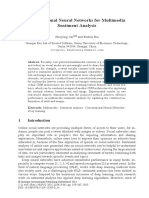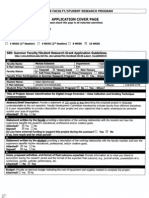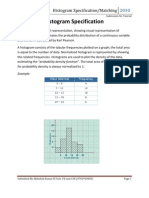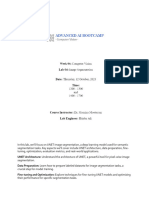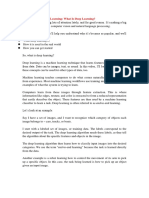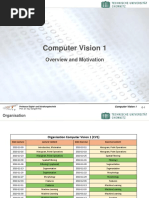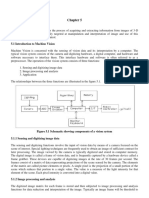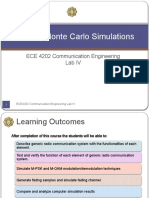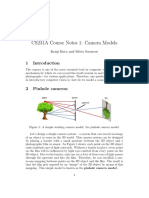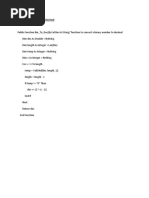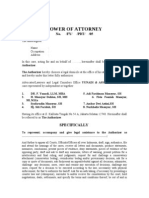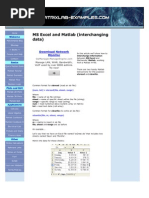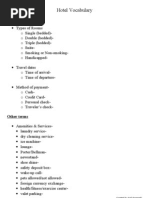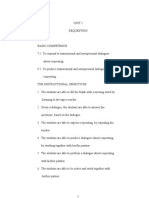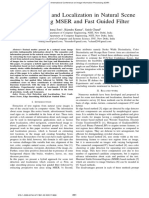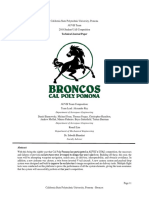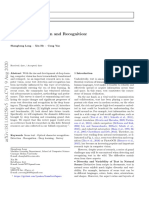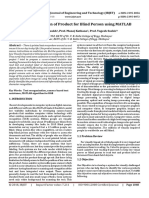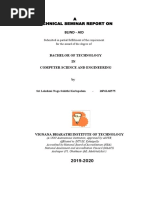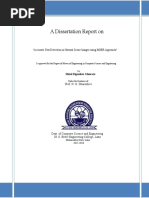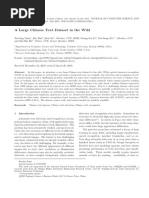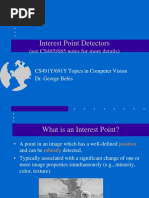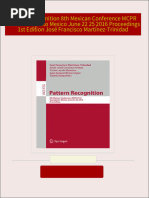Computer Vision Toolbox (Matlab)
Computer Vision Toolbox (Matlab)
Uploaded by
Hotland SitorusCopyright:
Available Formats
Computer Vision Toolbox (Matlab)
Computer Vision Toolbox (Matlab)
Uploaded by
Hotland SitorusOriginal Title
Copyright
Available Formats
Share this document
Did you find this document useful?
Is this content inappropriate?
Copyright:
Available Formats
Computer Vision Toolbox (Matlab)
Computer Vision Toolbox (Matlab)
Uploaded by
Hotland SitorusCopyright:
Available Formats
Computer Vision System Toolbox
Design and simulate computer vision and video processing systems
Computer Vision System Toolbox provides algorithms and tools for the design and simulation of computer vision and video processing systems. The toolbox includes algorithms for feature extraction, motion detection, object detection, object tracking, stereo vision, video processing, and video analysis. Tools include video file I/O, video display, drawing graphics, and compositing. Capabilities are provided as MATLAB functions, MATLAB System objects, and Simulink blocks. For rapid prototyping and embedded system design, the system toolbox supports fixed-point arithmetic and C code generation. Key Features Feature detection, including FAST, Harris, Shi & Tomasi, SURF, and MSER detectors Feature extraction and putative feature matching Object detection and tracking, including Viola-Jones detection and CAMShift tracking Motion estimation, including block matching, optical flow, and template matching RANSAC-based estimation of geometric transformations or fundamental matrices Video processing, video file I/O, video display, graphic overlays, and compositing Block library for use in Simulink Feature Detection and Extraction A feature is an interesting part of an image, such as a corner, blob, edge, or line. Feature extraction enables you to derive a set of feature vectors, also called descriptors, from a set of detected features. Computer Vision System Toolbox offers capabilities for feature detection and extraction that include: Corner detection, including Shi & Tomasi, Harris, and FAST methods SURF and MSER detection for blobs and regions Extraction of simple pixel neighborhood and SURF descriptors Visualization of feature location, scale, and orientation Additionally, the system toolbox provides functionality to match two sets of feature vectors and visualize the results. When combined into a single workflow, feature detection, extraction, and matching can be used to solve many computer vision design challenges, such as registration, stereo vision, object detection, and tracking.
SURF (left), MSER (center), and corner detection (right) with Computer Vision System Toolbox. Using the same image, the three different feature types are detected and results are plotted over the original image.
Registration and Stereo Vision Computer Vision System Toolbox supports automatic image registration by providing algorithms that use features to estimate the geometric relationships between images or video frames. Typical uses include video mosaicking, video stabilization, image fusion, and stereo vision. Feature-Based Registration Feature detection, extraction, and matching are the first steps in the feature-based registration workflow. With a pair of images, you can detect and extract features in each image, using one of several feature types available in the system toolbox. You can then determine putative matches between the two sets of features and visualize the matches. Typically, this workflow produces many interest points with matches that include outliers. You can remove the outliers with statistically robust methods such as RANSAC or least median of squares to compute a similarity, affine, or projective transformation. You can then apply the geometric transformation to align the two images.
Feature-based registration, used for video stabilization. The system toolbox detects interest points in two sequential video frames using corner features(top); the putative matches are determined with numerous outliers (bottom left), and outliers are removed using the RANSAC method (bottom right).
Stereo Image Rectification Stereo image rectification transforms a pair of stereo images so that a corresponding point in one image can be found in the corresponding row in the other image. You can rectify a pair of stereo images with the system toolbox by determining a set of matched interest points, estimating the fundamental matrix, and then deriving two projective transformations. This process reduces the 2D stereo correspondence problem to a 1D problem, which simplifies the process of determining the depth of each point in the scene from the camera.
Results from stereo image rectification. Non-overlapping areas are show in red and cyan.
Stereo Vision Stereo vision is the process of reconstructing a 3D scene from two or more views of the scene. Using the system toolbox, you can perform uncalibrated stereo image rectification on a pair of stereo images and match individual pixels along epipolar lines to compute a disparity map.
Reconstructing a scene using a pair of stereo images. To visualize the disparity, the right channel is combined with the left channel to create a composite (top left); also shown are a disparity map of the scene (top right) and a 3D rendering of the scene (bottom).
Object Detection, Motion Estimation, and Tracking Object detection is the identification of an object in an image or video. Computer Vision System Toolbox supports several approaches to object detection, including template matching, blob analysis, and the Viola-Jones algorithm. Template matching uses a small image, or template, to find matching regions in a larger image. Blob analysis uses segmentation and blob properties to identify objects of interest. The Viola-Jones algorithm uses Haar-like features and a cascade of classifiers to identify pretrained objects, including faces, noses, eyes, and other body parts.
Face detection using the Viola-Jones algorithm.
Motion estimation is the process of determining the movement of blocks between adjacent video frames. The system toolbox provides a variety of motion estimation algorithms, such as optical flow, block matching, template matching, and background estimation using Gaussian mixture models (GMMs). These algorithms create motion vectors, which relate to the whole image, blocks, arbitrary patches, or individual pixels. For block and template matching, the evaluation metrics for finding the best match include MSE, MAD, MaxAD, SAD, and SSD.
Detecting moving objects using a stationary camera. In this series of video frames, optical flow is calculated and detected motion is shown by overlaying the flow field on top of each frame.
Computer vision often involves the tracking of moving objects in video. Computer Vision System Toolbox provides video tracking algorithms, such as continuously adaptive mean shift (CAMShift) and Kanade-Lucas-Tomasi (KLT). You can use these algorithms for tracking a single object or as building blocks in a more complex tracking system. The system toolbox also provides a framework for multiple object tracking that includes Kalman filtering and the Hungarian algorithm for assigning objects to tracks. Learn how to integrate OpenCV and MATLAB Video Processing, Display, and Graphics Computer Vision System Toolbox provides algorithms and tools for video processing. You can read and write from common video formats, apply common video processing algorithms such as deinterlacing and chroma-resampling, and display results with text and graphics burnt in to the video. Video processing in MATLAB uses System objects, which avoids excessive memory use by streaming data for processing one frame at a time.
Video deinterlacing in MATLAB.
Video I/O Computer Vision System Toolbox can read and write multimedia files in a wide range of formats, including AVI, MPEG, and WMV. You can stream video to and from MMS sources over the Internet or a local network. You can acquire video directly from Web cameras, frame grabbers, DCAM-compatible cameras, and other imaging devices using Image Acquisition Toolbox. Simulink users can use the MATLAB workspace as a video source or sink. Video Display The system toolbox includes a video viewer that lets you: View video streams in-the-loop as the data is being processed View any video signal within your code or block diagram Use multiple video viewers at the same time Freeze the display and evaluate the current frame Display pixel information for a region in the frame Pan and zoom for closer inspection as the simulation is running Start, stop, pause, and step through Simulink simulations one frame at a time
Model with viewers for four videos: (from left) original, estimated background, foreground pixels, and results of tracking.
Graphics Adding graphics to video helps with visualizing extracted information or debugging a system design. You can insert text to display the number of objects or to keep track of other key information. You can insert graphics, such as markers, lines, and polygons to mark found features, delineate objects, or highlight other key features. The system toolbox functionality fuses text and graphics into the image or video itself rather than maintaining a separate layer. You can combine two video sources in a composite that can highlight objects or a key region.
Images with text and graphics inserted. Adding these elements can help you visualize extracted information and debug your design.
Stream Processing in MATLAB and Simulink Computer Vision System Toolbox supports a stream processing architecture in both MATLAB and Simulink. In a stream processing architecture, one or more video frames from a continuous stream are processed at a time. This type of processing is appropriate for analysis of large video files or systems with live video. In MATLAB, stream processing is enabled by System objects, which use MATLAB objects to represent time-based and data-driven algorithms, sources, and sinks. System objects implicitly manage many details of stream processing, such as data indexing, buffering, and the management of algorithm state. You can mix System objects with standard MATLAB functions and operators. Most System objects have corresponding Simulink blocks that provide the same capabilities. Simulink handles stream processing implicitly by managing the flow of data through the blocks that make up a Simulink model. It includes a library of general-purpose, predefined blocks to represent algorithms, sources, sinks, and system hierarchy. Computer Vision System Toolbox provides a library of blocks specifically for the design of computer vision and video processing systems.
An abandoned object detection model (top). The three viewers (bottom) show the process of detecting and tracking an abandoned object in a live video stream from a camera in a train station.
System Design and Implementation Computer Vision System Toolbox supports the creation of system-level test benches, fixed-point modeling, and code generation within both MATLAB and Simulink. This support lets you integrate algorithm development with rapid prototyping, implementation, and verification workflows. Fixed-Point Modeling Many real-time systems use hardware that requires fixed-point representation of your algorithm. Computer Vision System Toolbox supports fixed-point modeling in most blocks and System objects, with dialog boxes and object properties that help you with configuration. System toolbox support for fixed point includes: Word sizes from 1 to 128 bits Arbitrary binary-point placement Overflow handling methods (wrap or saturation) Rounding methods, including ceiling, convergent, floor, nearest, round, simplest, and zero Code Generation Support Most System objects, functions, and blocks in Computer Vision System Toolbox can generate ANSI/ISO C code using MATLAB Coder, Simulink Coder, or Embedded Coder. You can select optimizations for specific
processor architectures and integrate legacy C code with the generated code to leverage existing intellectual property. You can generate C code for both floating-point and fixed-point data types.
Simulink model designed to create code for a specific hardware target. This model generates C code for a video stabilization system and embeds the algorithm into a digital signal processor (DSP).
Image Processing Primitives Computer Vision System Toolbox includes image processing primitives that support fixed-point data types and C code generation. These System objects and Simulink blocks include: 2D spatial and frequency filtering Image pre- and postprocessing algorithms Morphological operators Geometric transformations Color space conversions
Resources
Product Details, Examples, and System Requirements www.mathworks.com/products/computer-vision Trial Software www.mathworks.com/trialrequest Sales www.mathworks.com/contactsales Technical Support www.mathworks.com/support Online User Community www.mathworks.com/matlabcentral Training Services www.mathworks.com/training Third-Party Products and Services www.mathworks.com/connections Worldwide Contacts www.mathworks.com/contact
2012 The MathWorks, Inc. MATLAB and Simulink are registered trademarks of The MathWorks, Inc. See www.mathworks.com/trademarks for a list of additional trademarks. Other product or brand names may be trademarks or registered trademarks of their respective holders.
10
You might also like
- Instant Ebooks Textbook Deep Generative Modeling Jakub M. Tomczak Download All ChaptersDocument49 pagesInstant Ebooks Textbook Deep Generative Modeling Jakub M. Tomczak Download All ChapterscboganziNo ratings yet
- Michael P. Ekstrom (Auth.) - Digital Image Processing Techniques (1984, Academic Press) PDFDocument379 pagesMichael P. Ekstrom (Auth.) - Digital Image Processing Techniques (1984, Academic Press) PDFApolinar TabañeraNo ratings yet
- Computer Vision55Document268 pagesComputer Vision55Fatima Al-Qudah100% (1)
- A Fuzzy Ontology and Its Application To News SummarizationDocument22 pagesA Fuzzy Ontology and Its Application To News Summarizationgula_gula100% (1)
- Music Genre Classification Using Machine Learning Techniques: April 2018Document13 pagesMusic Genre Classification Using Machine Learning Techniques: April 2018Sahil BansalNo ratings yet
- ManufacturingTechnology II GKV PDFDocument23 pagesManufacturingTechnology II GKV PDFfdsdNo ratings yet
- Convolutional Neural Networks For Multimedia Sentiment AnalysisDocument9 pagesConvolutional Neural Networks For Multimedia Sentiment AnalysisTamara KomnenićNo ratings yet
- Computer Vision Research ProposalDocument10 pagesComputer Vision Research ProposalAdam SteinbergerNo ratings yet
- Image Processing Using Matlab - Learning ToolDocument70 pagesImage Processing Using Matlab - Learning Toolskypillar88100% (1)
- Intro To COMPUTER VISIONDocument10 pagesIntro To COMPUTER VISIONSudhamsh MaddalaNo ratings yet
- Histogram SpecificationDocument6 pagesHistogram SpecificationAbhishek ShaolinNo ratings yet
- Computer VisionDocument13 pagesComputer VisiondavidrojasvNo ratings yet
- Lab 4-Image Segmentation Using U-NetDocument9 pagesLab 4-Image Segmentation Using U-Netmbjanjua35No ratings yet
- 00 Robotics Lec00Document14 pages00 Robotics Lec00Furkan KirmaciNo ratings yet
- Image Registration in Radiotherapy: Nilesh Kumar PG Radiation Physics Department of Radiation PhysicsDocument27 pagesImage Registration in Radiotherapy: Nilesh Kumar PG Radiation Physics Department of Radiation Physicsnilesh kumarNo ratings yet
- Object Detection Using Image ProcessingDocument17 pagesObject Detection Using Image ProcessingSumit SinghNo ratings yet
- Matlab Deep Learning SeriesDocument6 pagesMatlab Deep Learning Serieszym1003No ratings yet
- Computer Vision & Image ProcessingDocument34 pagesComputer Vision & Image ProcessingkcchtphdNo ratings yet
- Deep Learning For Image Processing Using MATLABDocument19 pagesDeep Learning For Image Processing Using MATLABNetaji GandiNo ratings yet
- Plant Disease IdentificationDocument17 pagesPlant Disease IdentificationSuresh BalpandeNo ratings yet
- Analytical Study On Object Detection Using Yolo AlgorithmDocument3 pagesAnalytical Study On Object Detection Using Yolo AlgorithmInternational Journal of Innovative Science and Research TechnologyNo ratings yet
- Math Work 1Document475 pagesMath Work 1kiranhebbarNo ratings yet
- Computer Vision 1Document16 pagesComputer Vision 1sara nasirNo ratings yet
- 2003 Siggraph PerezDocument6 pages2003 Siggraph Perezcjs2pcNo ratings yet
- Neural NetworkDocument220 pagesNeural NetworkMarcos CostaNo ratings yet
- Object Detection and IdentificationDocument8 pagesObject Detection and IdentificationVelumani sNo ratings yet
- Robotics Chapter 5 - Robot VisionDocument7 pagesRobotics Chapter 5 - Robot Visiontutorfelix777No ratings yet
- MSC Thesis Nordin SahlaDocument58 pagesMSC Thesis Nordin SahlaPrashant Pawar100% (1)
- Artificial Neural NetworksDocument43 pagesArtificial Neural NetworksanqrwpoborewNo ratings yet
- Reference: Digital Image Processing Rafael C. Gonzalez Richard E. WoodsDocument43 pagesReference: Digital Image Processing Rafael C. Gonzalez Richard E. WoodsNisha Joseph100% (1)
- HLSL TutorialDocument13 pagesHLSL TutorialMarkNo ratings yet
- Human Activity RecognitionDocument40 pagesHuman Activity RecognitionRasool ReddyNo ratings yet
- Lecture 7 - Simulation of Physical SystemsDocument33 pagesLecture 7 - Simulation of Physical SystemsanthonyNo ratings yet
- 20Ise652-Virtual RealityDocument61 pages20Ise652-Virtual RealitySravan KumarNo ratings yet
- Image Retrieval Using Both Color and Texture FeaturesDocument6 pagesImage Retrieval Using Both Color and Texture Featuresdivyaa76No ratings yet
- ML Notes Unit 1-2Document55 pagesML Notes Unit 1-2Mudit MattaNo ratings yet
- Restaurant Recommendation System Based On Collaborative FilteringDocument46 pagesRestaurant Recommendation System Based On Collaborative FilteringsiddharthNo ratings yet
- Computer VisionDocument41 pagesComputer VisionHarish ParuchuriNo ratings yet
- Swin Transformer Hierarchical Vision Transformer Using Shifted WindowsDocument11 pagesSwin Transformer Hierarchical Vision Transformer Using Shifted WindowsLakshya KarwaNo ratings yet
- Electronic Circuit Analysis Lecture NotesDocument2 pagesElectronic Circuit Analysis Lecture NotesRakib & My University (CSE, BSS)0% (1)
- Vision Systems Applications PDFDocument618 pagesVision Systems Applications PDFJorge PerdigonNo ratings yet
- Image ProcessingDocument38 pagesImage ProcessingJoy Thakur79% (14)
- 2018-19 A CC5004NI A2 CW2 CourseWork 17030830 Binod BelbaseDocument45 pages2018-19 A CC5004NI A2 CW2 CourseWork 17030830 Binod BelbaseRayan TiwariNo ratings yet
- Machine Learning Algorithms For Recommender System - A Comparative AnalysisDocument4 pagesMachine Learning Algorithms For Recommender System - A Comparative AnalysisATSNo ratings yet
- Image Processing For EngineersDocument438 pagesImage Processing For EngineersGabriel Ferreyra100% (1)
- R Deep Learning Essentials - Sample ChapterDocument24 pagesR Deep Learning Essentials - Sample ChapterPackt Publishing100% (3)
- Convolutional Neural NetworksDocument5 pagesConvolutional Neural NetworksYazan HassanNo ratings yet
- Sentiment AnalysisDocument5 pagesSentiment AnalysisShruti PantNo ratings yet
- Features 1 BDocument94 pagesFeatures 1 Bsai ramNo ratings yet
- Lab2 Monte Carlo SimulationsDocument73 pagesLab2 Monte Carlo SimulationsKhaleda Akhter SathiNo ratings yet
- Physics-Informed Deep-Learning For Scientific Computing PDFDocument19 pagesPhysics-Informed Deep-Learning For Scientific Computing PDFbluedancerNo ratings yet
- CS231A Course Notes 1: Camera Models: Kenji Hata and Silvio SavareseDocument17 pagesCS231A Course Notes 1: Camera Models: Kenji Hata and Silvio SavareseherusyahputraNo ratings yet
- Specification and Design of Embedded Software and Hardware SystemsDocument29 pagesSpecification and Design of Embedded Software and Hardware Systemsjude_vasiliNo ratings yet
- CNN-based and DTW Features For Human Activity Recognition On Depth MapsDocument14 pagesCNN-based and DTW Features For Human Activity Recognition On Depth Mapsjacekt89No ratings yet
- The 10 Algorithms Machine Learning Engineers Need To KnowDocument14 pagesThe 10 Algorithms Machine Learning Engineers Need To KnowNikhitha PaiNo ratings yet
- Computer Vision System ToolboxDocument10 pagesComputer Vision System ToolboxClaudia Angélica Rivera RomeroNo ratings yet
- Computer Vision System ToolboxDocument15 pagesComputer Vision System ToolboxsushilNo ratings yet
- Image Acquisition ToolboxDocument7 pagesImage Acquisition ToolboxUsman FarooqNo ratings yet
- Me Scope VesDocument10 pagesMe Scope Vestina1augmentosNo ratings yet
- Motion Estimation: Advancements and Applications in Computer VisionFrom EverandMotion Estimation: Advancements and Applications in Computer VisionNo ratings yet
- Decimal 2 BinerDocument2 pagesDecimal 2 BinerHotland SitorusNo ratings yet
- Introduction To Sequential ControlDocument2 pagesIntroduction To Sequential ControlHotland SitorusNo ratings yet
- Surat KuasaDocument2 pagesSurat KuasaHotland SitorusNo ratings yet
- The Blue and Green Colors Are Actually The SameDocument47 pagesThe Blue and Green Colors Are Actually The SameHotland SitorusNo ratings yet
- Natural Computing - Practical Assignment: Solving Traveling Salesman Problems With Nature-Inspired AlgorithmsDocument4 pagesNatural Computing - Practical Assignment: Solving Traveling Salesman Problems With Nature-Inspired AlgorithmsHotland SitorusNo ratings yet
- Metadata Extraction Tool ChangesDocument4 pagesMetadata Extraction Tool ChangesHotland SitorusNo ratings yet
- MS Excel and Matlab (Interchanging Data) : Download Network MonitorDocument3 pagesMS Excel and Matlab (Interchanging Data) : Download Network MonitorHotland SitorusNo ratings yet
- Principal Components Analysis: Vida MovahediDocument18 pagesPrincipal Components Analysis: Vida MovahediHotland SitorusNo ratings yet
- Interactive Face RecognitionDocument43 pagesInteractive Face RecognitionHotland Sitorus100% (1)
- Matlab - Development of Neural Network Theory For Artificial Life-Thesis - MATLAB and Java CodeDocument126 pagesMatlab - Development of Neural Network Theory For Artificial Life-Thesis - MATLAB and Java CodeHotland SitorusNo ratings yet
- Hotel Vocabulary: Reservation FormDocument13 pagesHotel Vocabulary: Reservation FormHotland SitorusNo ratings yet
- Matlab TutsDocument18 pagesMatlab TutsHotland SitorusNo ratings yet
- Matlab and Simulink Based Books: Clean Energy TechnologiesDocument1 pageMatlab and Simulink Based Books: Clean Energy TechnologiesHotland SitorusNo ratings yet
- Bahan Ajar Bahasa InggrisDocument66 pagesBahan Ajar Bahasa InggrisEty Dwi Jayanti100% (1)
- FLIR Accelerates Development of Thermal Imaging FPGA: User StoryDocument2 pagesFLIR Accelerates Development of Thermal Imaging FPGA: User StoryHotland SitorusNo ratings yet
- Scene Text Detection and Recognition USING DL PDFDocument20 pagesScene Text Detection and Recognition USING DL PDFBindu MadhuriNo ratings yet
- Text Detection and Localization in Natural Scene Images Using MSER and Fast Guided FilterDocument6 pagesText Detection and Localization in Natural Scene Images Using MSER and Fast Guided FilterParul NarulaNo ratings yet
- Real Time Road Sign Recognition System For Autonomous CarDocument14 pagesReal Time Road Sign Recognition System For Autonomous CarVipul MistryNo ratings yet
- Sir Shoaib Paper PDFDocument5 pagesSir Shoaib Paper PDFFarjad HaiderNo ratings yet
- Sustainability 16 02770 v2Document38 pagesSustainability 16 02770 v2ucherek42No ratings yet
- Auvsi Suas-2018-Journals-California State Polytechnic University PomonaDocument15 pagesAuvsi Suas-2018-Journals-California State Polytechnic University PomonaAdityaNo ratings yet
- Text Detection OCR Reseacrh PaperDocument26 pagesText Detection OCR Reseacrh PaperSameera LakshanNo ratings yet
- Text Recognization of Product For Blind Person Using MATLABDocument4 pagesText Recognization of Product For Blind Person Using MATLABPrathamesh PatilNo ratings yet
- ThesisDocument51 pagesThesisPROJECT POINTNo ratings yet
- Comparison of HOG, MSER, SIFT, FAST, LBP and CANNY Features For Cell Detection in Histopathological ImagesDocument6 pagesComparison of HOG, MSER, SIFT, FAST, LBP and CANNY Features For Cell Detection in Histopathological ImagesJake CloneyNo ratings yet
- 10023446Document5 pages10023446Harish GanapathyNo ratings yet
- X2 - Text Recognition PDFDocument14 pagesX2 - Text Recognition PDFMohammed A IsaNo ratings yet
- 6 Image Segmentation CombinedDocument40 pages6 Image Segmentation CombinedMuhammad Zaka Ud DinNo ratings yet
- 1st ReviewDocument14 pages1st ReviewEmi Ra Batte Baaz100% (1)
- A Novel Key-Point Detector Based On Sparse CodingDocument18 pagesA Novel Key-Point Detector Based On Sparse CodingsannikodavaliNo ratings yet
- Blind Aid ReportDocument41 pagesBlind Aid Reportsahithi karlapalemNo ratings yet
- Project Report On 2factor AuthenticationDocument91 pagesProject Report On 2factor AuthenticationSuraj ShindeNo ratings yet
- Text Extraction From Digital Images With Text To Speech Conversion and Language TranslationDocument3 pagesText Extraction From Digital Images With Text To Speech Conversion and Language TranslationInternational Journal of Innovative Science and Research TechnologyNo ratings yet
- A Large Chinese Text Dataset in The Wild: E-MailDocument13 pagesA Large Chinese Text Dataset in The Wild: E-MailkavithaNo ratings yet
- Remote User Recognition and Access ProvisionDocument54 pagesRemote User Recognition and Access Provisionjamessabraham2No ratings yet
- Matas MSER PDFDocument10 pagesMatas MSER PDFTomislav LivnjakNo ratings yet
- Interest Points DetectionDocument76 pagesInterest Points DetectionMaqdum HussainNo ratings yet
- Winter 2018-2019 Solutions: EE368/CS232 Digital Image ProcessingDocument25 pagesWinter 2018-2019 Solutions: EE368/CS232 Digital Image ProcessingRUBEN DARIO TAMAYO BALLIVIANNo ratings yet
- Automated Detection of Dyslexia Symptom Based On Handwriting Image For Primary School Children Automated Detection of Dyslexia Symptom Based On Handwriting Image For Primary School ChildrenDocument10 pagesAutomated Detection of Dyslexia Symptom Based On Handwriting Image For Primary School Children Automated Detection of Dyslexia Symptom Based On Handwriting Image For Primary School ChildrenMarilyn BucahchanNo ratings yet
- Pattern Recognition 8th Mexican Conference MCPR 2016 Guanajuato Mexico June 22 25 2016 Proceedings 1st Edition José Francisco Martínez-Trinidad 2024 scribd downloadDocument55 pagesPattern Recognition 8th Mexican Conference MCPR 2016 Guanajuato Mexico June 22 25 2016 Proceedings 1st Edition José Francisco Martínez-Trinidad 2024 scribd downloadroseypirri2c100% (5)
- Text Detection and Recognition Using Enhanced MSER Detection and A Novel OCR TechniqueDocument7 pagesText Detection and Recognition Using Enhanced MSER Detection and A Novel OCR TechniqueLeonardusNo ratings yet
- An Efficient Scheme For Automatic Pill Recognition Using Neural NetworksDocument8 pagesAn Efficient Scheme For Automatic Pill Recognition Using Neural NetworksAkbar aliNo ratings yet
- Computer Vision Toolbox (Matlab)Document10 pagesComputer Vision Toolbox (Matlab)Hotland SitorusNo ratings yet
- Detection of Lanes and Traffic Signs Painted On Road Using On-Board CameraDocument7 pagesDetection of Lanes and Traffic Signs Painted On Road Using On-Board CameraSharan RajNo ratings yet






